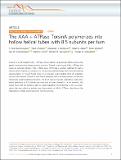The AAA + ATPase TorsinA polymerizes into hollow helical tubes with 8.5 subunits per turn
Author(s)
Demircioglu, Fatma Esra; Zheng, Weili; McQuown, Alexander J.; Maier, Nolan K.; Watson, Nicki; Denic, Vladimir; Egelman, Edward H.; Schwartz, Thomas; Cheeseman, Iain M; ... Show more Show less
DownloadPublished version (3.315Mb)
Terms of use
Metadata
Show full item recordAbstract
TorsinA is an ER-resident AAA + ATPase, whose deletion of glutamate E303 results in the genetic neuromuscular disease primary dystonia. TorsinA is an unusual AAA + ATPase that needs an external activator. Also, it likely does not thread a peptide substrate through a narrow central channel, in contrast to its closest structural homologs. Here, we examined the oligomerization of TorsinA to get closer to a molecular understanding of its still enigmatic function. We observe TorsinA to form helical filaments, which we analyzed by cryo-electron microscopy using helical reconstruction. The 4.4 Å structure reveals long hollow tubes with a helical periodicity of 8.5 subunits per turn, and an inner channel of ~ 4 nm diameter. We further show that the protein is able to induce tubulation of membranes in vitro, an observation that may reflect an entirely new characteristic of AAA + ATPases. We discuss the implications of these observations for TorsinA function.
Date issued
2019-07Department
Massachusetts Institute of Technology. Department of BiologyJournal
Nature Communications
Publisher
Springer Science and Business Media LLC
Citation
Demircioglu, F. Esra et al. "The AAA + ATPase TorsinA polymerizes into hollow helical tubes with 8.5 subunits per turn." Nature Communications 10, 1 (July 2019): 3262 © 2019 The Author(s)
Version: Final published version
ISSN
2041-1723